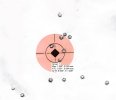Ah yes -- the old "full length or neck only" question. You've come to the right place to hear a lot of opinions.
Starting out with the lowest possible investment is good in my estimation, especially if your wife is wondering why this new-found hobby is costing so much. So here's my take on it:
A Lee press is probably not the place to start, but it will do for now. I used one long ago, and I found it looser and sloppier than more expensive ones. So think about each equipment purchase as "best possible for tightness of fitment and intended length of service."
As for neck sizing, there are two things (at least) that you are correcting for when sizing: returning the neck to its original size and shape, and returning the case to its original length. Each firing (and you did not say now often you shoot your brass) will slightly expand the brass. If you take a fired case and try to load it in an empty chamber, you will note that it (probably) goes it with more resistance than when new. That's because the dimensions have changed a little. If you have a micrometer you can measure this.
Dimensions of the neck are important for the grip on the bullet when the rifle goes off. If this is consistent, you'll have better repeatability.
Dimensions of the case shoulder (base to a datum line on the shoulder) will gradually get longer over repeated firings of a case. This is not affected by neck sizing. As an aside -- what is the datum line? It is a point on the shoulder that you can use to measure the case length with repeatability. People have measuring tools that allow you to measure this fairly accurately -- the Lock N Load by Hornady is probably the most common. You need a micrometer to use this tool.
If you have enough brass that you are only firing each piece two or three times, the shoulder bump is probably less important. If you are planning to shoot your brass until the primer pocket gets too large to hold a primer, you will want to full length resize, or at least find some way to "bump" the shoulder back about .002". You can do this with a full length resizing die or a shoulder bump die. In any case, you will probably want a case length comparator (Hornady LNL) and a micrometer to be able to do this repeatably.
Enjoy your new hobby!

